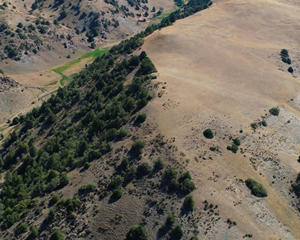The most famous examples -- Machu Picchu, Cusco, and Lhasa -- are often viewed as exceptions and remarkable examples of human resilience in extreme conditions.
But Tashbulak and Tugunbulak's location may have been chosen to harness strong mountain winds to fuel high-temperature fires needed to smelt metallic ores.
Limited excavations have revealed what appears to be a production kiln—likely a workshop where ancient smiths transformed the region's rich iron deposits into swords, armor, or tools.
有限的挖掘找到了某樣看似窯爐的構(gòu)造,它可能是古代鐵匠利用本地豐富的鐵礦鍛打?qū)殑Α⒖谆蚬ぞ叩墓し弧?/div>
"We need to investigate more, but we have a very strong sense that a major portion of the site was oriented around productive activities, smelting or other sorts of pyrotechnology," Frachetti says.
“我們需要進(jìn)行更多考察,不過(guò)我們強(qiáng)烈地感覺(jué)到,該遺址有很大一部分是圍繞燒窯、熔煉或其他使用火的生產(chǎn)活動(dòng)建造的,”弗拉切蒂說(shuō)。
"By mid-morning, the ground heats from the sun, and then you get a natural convection system with a long, hard wind that blasts up the mountainsides—a perfect condition for metalworking."
“晌午時(shí)分,大地被太陽(yáng)曬熱了,此時(shí),不息的勁風(fēng)涌上山坡,形成一套天然的對(duì)流系統(tǒng),為鍛冶創(chuàng)造了完美的條件。”
The researcher suspects that Tugunbulak's economy was driven by blacksmithing and other metalworking industries, capitalizing on the materials around them and their proximity to the Silk Road.
研究人員猜想,圖貢布拉克的經(jīng)濟(jì)動(dòng)力來(lái)自打鐵與其他鍛冶產(chǎn)業(yè),充分利用了周邊的材料以及靠近絲綢之路的地理優(yōu)勢(shì)。
"Iron and steel were the resources that everybody wanted, along with horses and warriors," Frachetti says.
“鐵與鋼就像馬匹與戰(zhàn)士一樣,是人人都渴望的資源,”弗拉切蒂說(shuō)。
"This was an age with a lot of rapid change, when everyone needed power to survive. These were the oil fields of the middle ages."
“這是一個(gè)瞬息萬(wàn)變的年代,任何民族都需要生存下去的實(shí)力。而這些就是中古時(shí)期的油田。”

For centuries, Silk Road historians have focused on the nomadic tribes and lowland empires that dominated the Uzbekistan region, often painting the highlands as marginal or peripheral to life in the valleys below.
幾個(gè)世紀(jì)以來(lái),絲綢之路歷史研究人員一直把注意力放在支配烏茲別克斯坦地區(qū)的游牧部落和低地帝國(guó)上,而高地往往被描繪成邊緣地帶或下方山谷生活的周邊輻射區(qū)域。
But the existence of extensive urban centers suggests that the mountains were home to their own distinct societies, with complex economies, political systems, and cultures.
但寬廣的城市中心的存在表明,山脈地區(qū)孕育了獨(dú)特的社會(huì),發(fā)展出了復(fù)雜的經(jīng)濟(jì)結(jié)構(gòu)、政治體系和文化生態(tài)。
The new discoveries raise the possibility that highland urbanism wasn't an anomaly in Central Asia, but part of a broader, more complex picture of medieval life.
考古新發(fā)現(xiàn)提高了這樣一種可能性,即高地城市化不是中亞的一種異態(tài),而是更加寬廣、復(fù)雜的中世紀(jì)生活畫卷的一部分。
"This puts a very big political entity at high altitude, in a zone that's outside of the normal agricultural realm, where you wouldn't expect to find a city of this size," says Frachetti.
“這種可能性就把一個(gè)非常龐大的政治實(shí)體放在了高海拔地區(qū),這里超出了常規(guī)農(nóng)業(yè)文明的范疇,沒(méi)有人曾想過(guò)會(huì)在這樣的地方找到如此規(guī)模的城市。”弗拉切蒂說(shuō)。
Further research will shed more light on who these people were, but it's already clear that they developed their own ways of life, separate from the typical agricultural societies of their time.
下一步的研究將繼續(xù)了解,哪些民族曾在這些高山古城中生活,但不論他們是誰(shuí),顯然都已發(fā)展形成了區(qū)別于同時(shí)期標(biāo)準(zhǔn)農(nóng)業(yè)社會(huì)的獨(dú)特的生活方式。
"If what we're discovering is a highland political realm that's differentiated from the lowlands, then it paints a very different picture of who the players were in medieval Central Asia," Frachetti says.
“假如我們正在發(fā)現(xiàn)的是一種有別于低地的高地政治地域,那么它將畫出一幅截然不同于過(guò)往認(rèn)知的中世紀(jì)中亞角逐者畫像。”弗拉切蒂說(shuō)。
"If we're right, we've got a new kid on the block," says Frachetti.
“如果我們推測(cè)的是正確的,那么這片地區(qū)的歷史便將迎來(lái)一位新加入者,”弗拉切蒂說(shuō)。
"These people weren't the barbarian horse-riding hordes that history has often painted them as. They were mountain populations, probably with nomadic political systems, but they were also investing in major urban infrastructure. This changes everything we thought we knew about Central Asian history."
“他們不像歷史上常常描繪的那樣,是馬背上的野蠻部落。他們是高山上的民族,很可能發(fā)展出了游牧政治體系;而他們同時(shí)也發(fā)展了大型城市基礎(chǔ)設(shè)施。這改變了我們自認(rèn)為了解的有關(guān)中亞歷史的一切。”












